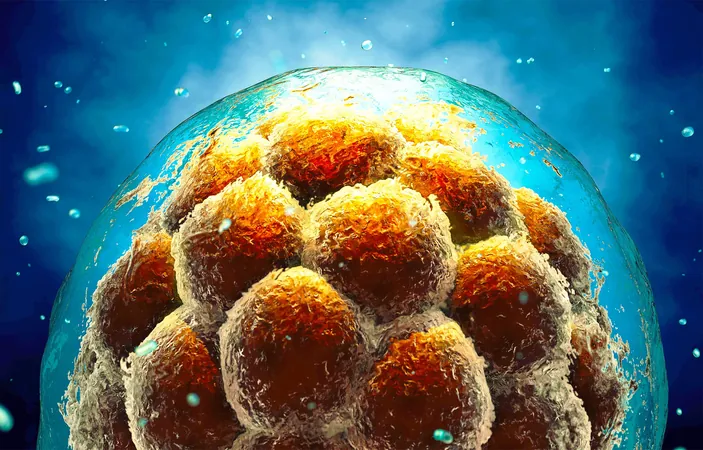
Unlocking the Mysteries of Development: How LoxCode Sheds Light on Cellular Fate
2025-06-29
Author: Jia
The Marvel of Cellular Development
Have you ever wondered how a single fertilized egg transforms into a complex organism with distinct body parts like skin, brain, and blood? The key to this incredible transformation lies in the decisions made by each cell during early development. But what determines whether a cell will become a kidney or skin? This age-old question has puzzled scientists for over a century.
Introducing LoxCode: The Game-Changer in Cell Tracking
Recently, researchers from Australia unveiled a groundbreaking tool called LoxCode, which reveals just how cells track their destinies within a developing embryo. By assigning each cell in a mouse embryo a unique DNA tag, this ingenious technology acts as a barcode, allowing scientists to monitor cell lineage with unprecedented precision.
A Deep Dive into Developmental Biology
Dr. Tom Weber, one of the leading scientists at the Walter and Eliza Hall Institute, emphasized the significance of this tool: "This creates a trackable barcode, allowing us to peer inside this fundamental process with unprecedented detail." Using LoxCode, scientists can follow each cell from its origin through the complex formation of tissues.
Breaking New Ground with Innovative Techniques
LoxCode utilizes the Cre recombinase enzyme to create over 30 billion distinct barcodes through a unique shuffling of DNA cassettes. By injecting these barcodes at a critical stage of pregnancy, researchers can later reconstruct family trees of cells, revealing insights that were previously hidden. For example, they discovered that some cells begin to show a bias towards specific tissues much earlier than traditional biology textbooks have suggested.
Revealing the Hidden Biases of Cells
The research indicated that pluripotent cells—once thought to be blank slates waiting for external cues—actually begin specializing based on their position within the embryo. Early findings showed that certain cells were already inclined to develop into blood or neural tissues before other developmental processes, like gastrulation, even began.
Unpacking the Asymmetries of Development
One particularly surprising result was the observation that left and right limb buds often traced back to different cell origins, highlighting an element of randomness rather than perfect symmetry. These revelations may shed light on congenital disorders, explaining why some conditions affect only one side of the body and potentially helping stem-cell engineers create more balanced organoids.
Broad Applications for the Future
LoxCode isn't just a breakthrough for embryology—it holds vast potential for numerous fields in medicine. From studying immune development to cancer therapies, researchers are already adapting this technology to examine how cells react in various contexts, like after a stroke. By mapping out the ancestry of individual cells, they hope to unravel complexities related to therapy resistance in cancer treatments.
Transforming the Future of Medical Science
The implications of LoxCode extend far beyond basic research. By pinpointing mis-timed cellular decisions that can lead to developmental disorders, scientists can revolutionize targeted gene therapies. Instead of treating symptoms, interventions could be designed to correct issues at the source. For transplant procedures, LoxCode could help ensure lab-grown tissues contain the right cell types for successful surgical outcomes.
Looking Ahead: The Ethical Landscape
While LoxCode has the potential to transform our understanding of early development, it also raises ethical considerations—especially if similar techniques are applied to human embryos. For now, the focus remains on mouse models, where this innovative tool promises to rewrite our understanding of embryonic development.




 Brasil (PT)
Brasil (PT)
 Canada (EN)
Canada (EN)
 Chile (ES)
Chile (ES)
 Česko (CS)
Česko (CS)
 대한민국 (KO)
대한민국 (KO)
 España (ES)
España (ES)
 France (FR)
France (FR)
 Hong Kong (EN)
Hong Kong (EN)
 Italia (IT)
Italia (IT)
 日本 (JA)
日本 (JA)
 Magyarország (HU)
Magyarország (HU)
 Norge (NO)
Norge (NO)
 Polska (PL)
Polska (PL)
 Schweiz (DE)
Schweiz (DE)
 Singapore (EN)
Singapore (EN)
 Sverige (SV)
Sverige (SV)
 Suomi (FI)
Suomi (FI)
 Türkiye (TR)
Türkiye (TR)
 الإمارات العربية المتحدة (AR)
الإمارات العربية المتحدة (AR)